******* HISTORY OF EASTER CACTI *******
**** (OR RHIPSALIDOPSIS OR HATIORA) ****
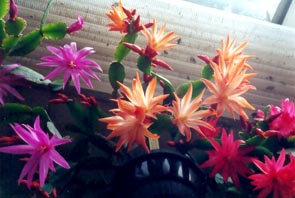
In my opinion, Easter cacti are a too much ignored genus among epiphytic cacti. They are especially appreciated by the general public, less by cactophiles, with the advantages and the disadvantages of this situation.
Easter cacti are often mixed up with Christmas cacti by many people, including
by some garden-centers professional shop assistants. This is probably due
to the fact that the non blooming plants growth of both kinds vaguely look
alike if you don't observe them closely : Easter cacti stem-segments have
the same flattened and rounded shape as Christmas cacti’s, particularly
in the case of Schlumbergera hybrids which are close relatives of Schlumbergera
russelliana (see 1 or R shape of the stem-segments on the first of my pages
about Christmas cacti).
But, as soon as the flowers are open, there’s no confusion
possible any longer: Christmas cacti bloom between September and February,
whereas Easter cacti bloom between April and July (blooming period given for
plants grown in the Northern hemisphere).
The bloom shape is also different (see the two photographs below):
Christmas cacti have zygomorphic blooms, i.e. blooms have a plan of symmetry
; in this case, the plan of symmetry contains the pistil axis. The pistil
is very long ; thus Christmas cacti are pollinated, in their biotope, by hummingbirds.
The Easter cacti have actinomorphic blooms, i.e. blooms have an axis of symmetry,
which is here the pistil axis. The pistil is very short and the blooms are
star- or cone-shaped.
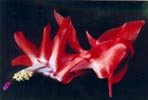 ...............................................................................
...............................................................................
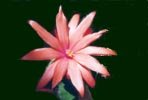
Christmas Cactus *********************************************** Easter Cactus
BOTANICAL ANCESTRORS
 The botanical ancestors are the two known species of the
genus Rhipsalidopsis. Nowadays this genus is sometimes included in the genus
Hatiora.
The botanical ancestors are the two known species of the
genus Rhipsalidopsis. Nowadays this genus is sometimes included in the genus
Hatiora.
Rhipsalidopsis (because they look like Rhipsalis), were classified, throughout
their history, into several genera : Epiphyllum, Schlumbergera, Epiphyllopsis.
Botanical Rhipsalidopsis grow as epiphytes in the forests of South Brazil, in the States of Minas Gerais , Sao Paulo, Parana, Santa Catarina and Rio Large del Sul, (red zone on the map). These locations are close to those of botanical Schlumbergera (Christmas Cacti).
Botanic Rhipsalidopsis are made up of two species: Rhipsalidopsis
rosea and Rhipsalidopsis gaertneri.
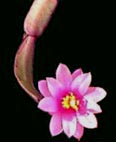 ...................................................................
................................................................... 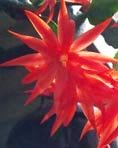
Rhipsalidopsis rosea *********************************** Rhipsalidopsis gaertneri
Rhipsalidopsis rosea has flattened stem-segments, 2 to 4 centimetres long and 1 centimetre wide ; it has pink blooms of 3 to 4 centimeters in diameter. It has been described since 1912 by Lagerheim, in a Britton and Rose's book.
Rhipsalidopsis gaertneri has larger stem-segments, 4 to 7 centimetres long and 2 to 2.5 centimetres wide. Its blooms are a scarlet red colour ; they are 4 to 7.5 centimetres in diameter. It has been described since 1884 by the German botanist von Regel.
The two species have several varieties.
All Rhipsalidopsis hybrids were made by the use of these two
species,.
BRIEF HISTORY OF THE HYBRIDS
The hybrids’ history started in 1932. Then, cacti producer Alfred Graser started to cross the two previously metioned botanical species, taking the pollen from Rhipsalidopsis rosea and depositing it in the pistil of Rhipsalidopsis gaertneri. He obtained several hybrids, named Rhipsalidopsis X graeseri.
In 1985, in the English review "Epiphytes", 44 cultivars of Rhipsalidopsis hybrids were mentioned.
From 1950 to 1960, the hybrids creation continued in
Anglo-Saxon countries : in the United Kingdom and in California in
‘Johnson Cactus Gardens’, in Florida as well, where the famous
hybridizer Cobia, created also Schlumbergera X ‘Gold Charm’, the
first yellow blooming Christmas cactus ever.
Rhipsalidopsis Hybrids have also been created by Abbey Brooks Cactus Nursery
and by members of the Epiphytic Plant Study Group among whom John Horobin,
co-author with A.J.S McMillan of the book : ‘Christmas Cacti’
(reference book about Christmas cacti)
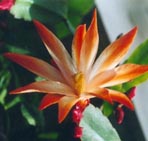
Rhipsalidopsis X "Parnell"
Hybrids are also created in Australia, in Japan, (country of origin of the splendid bicoloured hybrid: ‘Parnell’), in Denmark, in Germany and in the Netherlands where the first white blooming Easter cactus appeared : Rhipsalidopsis X ‘Sirius’, which I was lucky to be able to buy at a French garden-center, the first year of its marketing in France, in 2003. As an anecdote, the garden-center referred to was unaware of the fact that it was selling a new plant ; it wrongly believed it was selling a plant which had existed for many years !!
A yellow blooming hybrid was recently created
in the Netherlands, but is not yet marketed.
As early as 1995, in his reference article about Rhipsalidopsis (in ‘Haseltonia’
: the Cactus and Succulent Society of America review) Eckard Meier mentioned
a list containing more than 200 Rhipsalidopsis hybrid cultivars.
ORIGINS OF WHITE OR YELLOW BLOOMING HYBRIDS
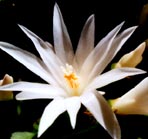
Rhipsalidopsis X "Sirius"
I was immediately intrigued by the origin of yellow or white blooming Rhipsalidopsis hybrids, because it was the first time that these unusual colors had appeared in the Rhipsalidopsis genus whose two ancestors have pink or scarlet red blooms (see above). Thus I wanted to know more about it. I wrote to the producer who had marketed my Rhipsalidopsis X "Sirius" to ask him for more details. He told me that the hybrid had been obtained by crossings, and that the efforts necessary to the obtention had lasted 10 years. I couldn't learn more about it. I tried to clarify the following questions :
Was the origin due to a mutation or a color selection ? (as for Schlumbergera X ‘Gold Charm’)
One more hypothesis could be the crossing of a Rhipsalidopsis with a yellow bloomig Hatiora as for Hatiora salicornioides or with a Rhipsalis (white flowers). This hypothesis doesn't seem impossible although the only intergeneric hybrids created with Rhipsalidopsis were made with Schlumbergera. (to my knowledge). Several English cacti producers, as well as a German botanist, with whom I exchanged mails on this topic, think that the hypothesis of a color mutation or a selection of pale coloured blooming clones are the most probable explanations. Several crossings must have been likely after the mutation or the selection. This would explain the relatively long time, between the beginning of research and the marketing year.
So for me as for many other people, the mystery is still unsolved.
GROWING AND BLOOMING OF EASTER CACTI
Easter cacti have about the same growing requirements as those of Christmas cacti ; this is logical, considering the analogy and the proximity of the botanical ancestors habitats. Perhaps, however, Easter cacti require a slightly sunnier location than Christas cacti.
The compost must be acid and well drained and always slightly wet, especially from March to October. During this period, I water all my Easter cacti approximately once every 10 days. During the winter, I slightly sprinkle them approximately once every three weeks. Waterings are always made with rainwater.
From October to March, the minimal temperature
must fall down to approximately 10°C ; if this fall isn't respected, plants
don't bloom. From March to October, I maintain the temperature between 10
and 25°C. Above 25°C, the plants have a
tendency to wilt. Like all my epiphytes, Rhipsalidopsis just love spending
an outside summer stay in my garden.
The hybrids close to Rhipsalidopsis rosea and Rhipsalidopsis rosea itself are a little bit more difficult to grow than the other ones. The root system can wither during the winter and the plants wilt, then dry out. Then, it's necessary to cut stem-segment in time and to make cuttings in a wet, warm and bright location, for example inside the house, using horticultural lamps to light the cuttings. The same treatment is also convenient if some stem-segment base is beginning to rot.
In my greenhouse, Easter cacti blooming occurs from May to July. Producers obtain blooming plants exactly for the Easter period by artificially obtaining earlier spring conditions to have blooms exactly when they want.
After flowering, it is necessary to manually prune the fruits.
Thus, they don't develop and the plants don't unnecessarily tire out.
WHERE TO GET EASTER CACTI ?
As I wrote above, the Easter cacti particularly have the interest of the general public, but a far lesser interest of the cactophiles. Consequently, they can be especially found in the garden-centers, rather than in the specialized cacti nurseries which usually haven't a wide choice.
For my part, I was lucky to be able to import the majority of
my Rhipsalidopsis from the United States. They come from the famous producer
: Rainbow Gardens, alas retired now. Besides they had stopped sending cuttings
outside the USA several years before retiring. The reason was the weight and
the cost of the administrative harrassments (CITES regulations,
phytosanitary certificates, customs), necessary to legally export.Thus,
the wonderful American market became, alas, more and more inaccessible to
European collectors.
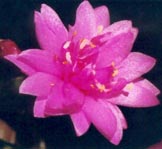
Rhipsalidopsis X "Double China Rose"
(obtention : Everson & Williams, Rainbow Gardens)
As for garden-centers, every year they sell new, healthy and beautiful hybrids, but they are always unnamed. Wholesale producers who provide garden-centers do not consider that it's necessary to put identification labels for two reasons : the cost of labelling and the general public’s lack of interest.
It is thus relatively difficult to get identified hybrids, the only means possible being to make the round of many producers, or to find private collectors who sell or who exchange. I thank in advance any collector who would be ready to and who would like to contact me.
THE GALLERY OF THE PHOTOS OF ALL MY EASTERCACTI
This gallery was made up starting with the photographs of Rhipsalidopsis of my collection, already present elsewhere in my site, but scattered on several pages. I gathered them (by adding news) on a special page which is the gallery of all Rhipsalidopsis having bloomed so far in my collection.
This page would never have been so documented without
precious documentation found in the reference article on Rhipsalidopsis,
written by Eckhard MEIER, in the review Haseltonia, volume3, 1995. (book
available at
Whitestone Gardens bookshop, whose address is on my links page).
HOME PAGE .................................
TO ENTER THE GALLERY OF ALL MY RHIPSALIDOPSIS
________________________________________________________________________